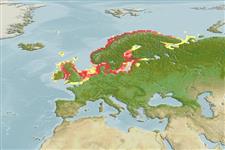Common names from other countries
Environment: milieu / climate zone / depth range / distribution range
Ecologie
marien; brak water demersaal; diepte 0 - 40 m (Ref. 31184), usually 2 - 20 m (Ref. 35388). Temperate; 72°N - 49°N, 11°W - 52°E
Northeast Atlantic: White Sea, Cheshskaya Guba and Murmansk coast (Barents Sea) southward to English Channel (River Somme); eastern coasts of Scotland, England, also Irish Sea; the Orkneys, Shetlands and in shallow waters of North Sea and Baltic.
Lengte bij maturiteit / Grootte / Gewicht / Leeftijd
Maturity: Lm 17.0, range 16 - 18 cm
Max length : 52.0 cm TL mannelijk / geslacht onbekend; (Ref. 4695); common length : 30.0 cm TL mannelijk / geslacht onbekend; (Ref. 4695); max. gepubliceerd gewicht: 510.00 g (Ref. 6397); max. gerapporteerde leeftijd: 10 Jaren (Ref. 35388)
Bones are green due to harmless pigment. Skin slimy and variable color (Ref. 35388).
Inhabits rocky shores under stones, among algae and in tide pools, between tide marks down to 40 m. May remain out of water under rocks or seaweeds (Ref. 31184). Feeds on gastropods, chironomids, crustaceans, eggs and fry of fishes. Gives birth to live young (Ref. 9900). Bones colored green by the harmless pigment Vivianit (Ref. 4645). Breathes air when out of water (Ref. 31184). Mating takes place in August - September with internal fertilization of the eggs. Female give birth to 30-400 developed young (35-55mm) (Ref. 35388).
Levenscyclus en paargedrag
Maturiteit | Voortplanting | Paaien | Eieren | Fecunditeit | Larven
Fertilization occurs in August-September. Egg development lasts for one month. Total bearing time is five months (Ref. 6397).
Andriashev, A.P., 1986. Zoarcidae. p. 1130-1150. In P.J.P. Whitehead, M.-L. Bauchot, J.-C. Hureau, J. Nielsen and E. Tortonese (eds.) Fishes of the North-eastern Atlantic and the Mediterranean. volume 3. UNESCO, Paris. (Ref. 4695)
Status op de Rode Lijst van het IUCN (Ref. 130435)
CITES (Ref. 128078)
Not Evaluated
Gevaar voor de mens
Harmless
Gebruik door de mens
Visserij: van minder commercieel belang; Aquarium: Publieke aquaria
Tools
Speciale rapporten
Download XML
Internetbronnen
Estimates based on models
Preferred temperature (Ref.
115969): 7.3 - 11.3, mean 9.4 (based on 310 cells).
Fylogenetische diversiteitsindex (Ref.
82804): PD
50 = 0.5156 [Uniqueness, from 0.5 = low to 2.0 = high].
Bayesian length-weight: a=0.00316 (0.00188 - 0.00531), b=3.13 (2.97 - 3.29), in cm Total Length, based on LWR estimates for this species & (Sub)family-body (Ref.
93245).
Trofisch niveau (Ref.
69278): 3.5 ±0.49 se; based on food items.
Weerstandsvermogen (Ref.
120179): laag, minimale populatieverdubbelingstijd 4,5-14 jaar (tm=2; tmax=10; Fec=30; K=0.19-0.4).
Fishing Vulnerability (Ref.
59153): High vulnerability (60 of 100).
Climate Vulnerability (Ref.
125649): Very high vulnerability (84 of 100).
